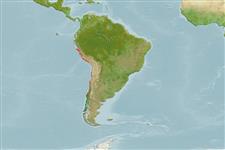Teleostei (teleosts) >
Perciformes/Scorpaenoidei (Scorpionfishes) >
Normanichthyidae (Barehead scorpionfishes)
Etymology: Normanichthys: Because of John Roxburgh Norman, British ichthyiologist 1898-1944 (Ref. 45335).
Eponymy: John Roxborough Norman (1898–1944) was an English ichthyologist who started his working life as a bank clerk. [...] Charles Templeton Crocker (1885–1948) was a member of a California family that made its money from railways, having invested in the first transcontinental American railroad. [...] (Ref. 128868), visit book page.
Issue
Needs a taxonomic reference.
Environment: milieu / climate zone / depth range / distribution range
Ecology
Marine; demersal, usually 37 - 200 m (Ref. 557). Tropical; 9°S - 38°S
Southeast Pacific: Chimbote, Peru to Isla Mocha, Chile.
Size / Weight / Age
Maturity: Lm ? range ? - ? cm
Max length : 11.0 cm TL male/unsexed; (Ref. 557)
Life cycle and mating behavior
Maturity | Reproduction | Spawning | Eggs | Fecundity | Larvae
IUCN Red List Status (Ref. 130435: Version 2025-1)
Threat to humans
Harmless
Human uses
Fisheries: commercial
Tools
Special reports
Download XML
Internet sources
Estimates based on models
Preferred temperature (Ref.
123201): 10.5 - 15.6, mean 13.1 °C (based on 37 cells).
Phylogenetic diversity index (Ref.
82804): PD
50 = 1.5000 [Uniqueness, from 0.5 = low to 2.0 = high].
Bayesian length-weight: a=0.01122 (0.00514 - 0.02450), b=3.04 (2.87 - 3.21), in cm total length, based on all LWR estimates for this body shape (Ref.
93245).
Trophic level (Ref.
69278): 2.8 ±0.18 se; based on food items.
Resilience (Ref.
120179): High, minimum population doubling time less than 15 months (Assuming tm<=1).
Fishing Vulnerability (Ref.
59153): Low vulnerability (10 of 100).
🛈
Climate Vulnerability (Ref.
125649): Moderate vulnerability (41 of 100).
🛈
Nutrients (Ref.
124155): Calcium = 240 [114, 783] mg/100g; Iron = 1.63 [0.77, 3.33] mg/100g; Protein = 16.3 [14.7, 17.8] %; Omega3 = 0.442 [0.172, 1.243] g/100g; Selenium = 65.3 [25.7, 179.6] μg/100g; VitaminA = 72.3 [19.5, 269.5] μg/100g; Zinc = 1.89 [1.15, 3.05] mg/100g (wet weight);
